Degradation Behavior of Biodegradable Man-Made Fibers in Natural Soil and in Compost
Abstract
1. Introduction
2. Materials and Methods
2.1. Materials
- -
- type T400, fineness 6.7 dtex, material: PLA (density ~ 1.25 g cm−3 → approximately d = 26 µm)
- -
- type T453, fineness 2.2 dtex, bicomponent (BICO) fiber, core material: PLA, shell material: PBS (density ~ 1.25 g cm−3 → approximately d = 15 µm),
- -
- type V400, fineness 1.7 dtex, material: PHA/PLA blend (density ~ 1.25 g cm−3 → approximately d = 13 µm).
2.2. Sample Preparation
2.3. Natural Soil Burial Test
2.4. Compost Burial Test
2.5. Mechanical Tests
2.6. Gel Permeation Chromatography (GPC)
2.7. Scanning Electron Microscope (SEM)
2.8. Attenuated Total Reflectance Fourier Transform Infrared Spectrometer (ATR-FT-IR)
2.9. Differential Scanning Calorimetry (DSC)
3. Results
3.1. Natural Soil/Ambient Temperature
3.1.1. Natural Soil: Microscopy
3.1.2. Natural Soil: Mechanics/Molecular Weight/FT-IR/DSC Characterization
3.2. Compost/Elevated Temperature
3.2.1. Compost: Microscopy
3.2.2. Compost: Mechanics/Molecular Weight/FT-IR/DSC Characterization
4. Discussion
5. Conclusions and Outlook
Supplementary Materials
Author Contributions
Funding
Institutional Review Board Statement
Data Availability Statement
Acknowledgments
Conflicts of Interest
References
- Smith, O.; Brisman, A. Plastic Waste and the Environmental Crisis Industry. Crit. Criminol. 2021, 29, 289–309. [Google Scholar] [CrossRef] [PubMed]
- Filho, W.L.; Salvia, A.L.; Bonoli, A.; Saari, U.A.; Voronova, V.; Klõga, M.; Kumbhar, S.S.; Olszewski, K.; de Quevedo, D.M.; Barbir, J. An assessment of attitudes towards plastics and bioplastics in Europe. Sci. Total Environ. 2021, 755, 142732. [Google Scholar] [CrossRef] [PubMed]
- Flury, M.; Narayan, R. Biodegradable plastic as an integral part of the solution to plastic waste pollution of the environment. Curr. Opin. Green Sustain. Chem. 2021, 30, 100490. [Google Scholar] [CrossRef]
- World Economic Forum; Ellen MacArthur Foundation and McKinsey & Company. The New Plastics Economy—Rethinking the Future of Plastics (2016, Publications|Ellen MacArthur Foundation). Available online: https://emf.thirdlight.com/file/24/_A-BkCs_skP18I_Am1g_JWxFrX/The%20New%20Plastics%20Economy%3A%20Rethinking%20the%20future%20of%20plastics.pdf (accessed on 1 July 2023).
- Pogrell, H.V. Bio-Based Plastics—Fostering a Resource Efficient Circular Economy: Benefits, Feedstock Types, Sustainable Sourcing, Land Use. Available online: https://docs.european-bioplastics.org/publications/fs/EuBP_FS_Renewable_resources.pdf (accessed on 1 July 2023).
- Burgstaller, M.; Potrykus, A.; Weißenbacher, J.; Kabasci, S.; Merrettig-Bruns, U.; Sayder, B. Gutachten zur Behandlung Biologisch Abbaubarer Kunststoffe. Available online: https://www.umweltbundesamt.de/sites/default/files/medien/421/publikationen/18-07-25_abschlussbericht_bak_final_pb2.pdf (accessed on 1 July 2023).
- Itävaara, M.; Karjomaa, S.; Selin, J.-F. Biodegradation of polylactide in aerobic and anaerobic thermophilic conditions. Chemosphere 2002, 46, 879–885. [Google Scholar] [CrossRef]
- Lambert, S. Environmental Risk of Polymers and their Degradation Products. Ph.D. Thesis, University of York, York, UK, 2013. [Google Scholar]
- Gu, J.-D. Microbiological deterioration and degradation of synthetic polymeric materials: Recent research advances. Int. Biodeterior. Biodegrad. 2003, 52, 69–91. [Google Scholar] [CrossRef]
- Zumstein, M.T.; Schintlmeister, A.; Nelson, T.F.; Baumgartner, R.; Woebken, D.; Wagner, M.; Kohler, H.-P.E.; McNeill, K.; Sander, M. Biodegradation of synthetic polymers in soils: Tracking carbon into CO2 and microbial biomass. Sci. Adv. 2018, 4, eaas9024. [Google Scholar] [CrossRef]
- Gupta, B.; Revagade, N.; Hilborn, J. Poly(lactic acid) fiber: An overview. Prog. Polym. Sci. 2007, 32, 455–482. [Google Scholar] [CrossRef]
- Yang, Y.; Zhang, M.; Ju, Z.; Tam, P.Y.; Hua, T.; Younas, M.W.; Kamrul, H.; Hu, H. Poly(lactic acid) fibers, yarns and fabrics: Manufacturing, properties and applications. Text. Res. J. 2021, 91, 1641–1669. [Google Scholar] [CrossRef]
- PLA FIBRES: Sustainable Man-Made Fibres. Available online: https://www.trevira.de/en/fibres/biopolymer-fibres (accessed on 1 July 2023).
- Shi, X.Q.; Ito, H.; Kikutani, T. Characterization on mixed-crystal structure and properties of poly(butylene adipate-co-terephthalate) biodegradable fibers. Polymer 2005, 46, 11442–11450. [Google Scholar] [CrossRef]
- Li, X.; Liu, J.; Lu, Y.; Hou, T.; Zhou, J.; Zhang, X.; Zhou, L.; Sun, M.; Xue, J.; Yang, B. Melting centrifugally spun ultrafine poly butylene adipate-co-terephthalate (PBAT) fiber and hydrophilic modification. RSC Adv. 2021, 11, 27019–27026. [Google Scholar] [CrossRef]
- Li, F.; Luo, S.; Yu, J. Mechanical, thermal properties and isothermal crystallization kinetics of biodegradable poly(butylene succinate-co-terephthalate) (PBST) fibers. J. Polym. Res. 2010, 17, 279–287. [Google Scholar] [CrossRef]
- Shi, X.Q.; Takasaki, M.; Ito, H.; Kikutani, T. Structural Development and Properties of Melt Spun Poly(butylene succinate) and Poly(butylene terephthalate-co-succinate-co-adipate) Biodegradable Fibers. Int. Polym. Process. 2006, 21, 64–69. [Google Scholar] [CrossRef]
- Salmawy, A.E.L.; Yamane, H.; Miyamoto, M.; Kimura, Y. Properties and Degradability of Melt-spun Fibers of Poly(butylene succinate) and its Copolymer with L-Lactic Acid. Sen-i Gakkaishi 1999, 55, 120–126. [Google Scholar] [CrossRef] [PubMed]
- Nakano, S.; Salmawy, A.E.L.; Nakamura, T.; Kimura, Y. Properties and Enzymatic Degradability of Melt-Spun Fibers of Poly(butylene succinate) and Its Various Derivatives. Sen-i Gakkaishi 2002, 58, 209–215. [Google Scholar] [CrossRef]
- Ostheller, M.-E.; Abdelgawad, A.M.; Balakrishnan, N.K.; Hassanin, A.H.; Groten, R.; Seide, G. Curcumin and Silver Doping Enhance the Spinnability and Antibacterial Activity of Melt-Electrospun Polybutylene Succinate Fibers. Nanomaterials 2022, 12, 283. [Google Scholar] [CrossRef]
- Yamane, H.; Terao, K.; Hiki, S.; Kimura, Y. Mechanical properties and higher order structure of bacterial homo poly(3-hydroxybutyrate) melt spun fibers. Polymer 2001, 42, 3241–3248. [Google Scholar] [CrossRef]
- Vogel, R.; Tändler, B.; Häussler, L.; Jehnichen, D.; Brünig, H. Melt spinning of poly(3-hydroxybutyrate) fibers for tissue engineering using alpha-cyclodextrin/polymer inclusion complexes as the nucleation agent. Macromol. Biosci. 2006, 6, 730–736. [Google Scholar] [CrossRef]
- Schmack, G.; Jehnichen, D.; Vogel, R.; Tändler, B. Biodegradable fibers of poly(3-hydroxybutyrate) produced by high-speed melt spinning and spin drawing. J. Polym. Sci. B Polym. Phys. 2000, 38, 2841–2850. [Google Scholar] [CrossRef]
- Park, S.-W.; Kim, S.-H.; Choi, H.-S.; Cho, H.-H. Preparation and physical properties of biodegradable polybutylene succinate/polybutylene adipate-co-terephthalate blend monofilament by melt spinning. Bull. Korean Soc. Fish. Technol. 2010, 46, 257–264. [Google Scholar] [CrossRef]
- Jompang, L.; Thumsorn, S.; On, J.W.; Surin, P.; Apawet, C.; Chaichalermwong, T.; Kaabbuathong, N.; O-Charoen, N.; Srisawat, N. Poly(Lactic Acid) and Poly(Butylene Succinate) Blend Fibers Prepared by Melt Spinning Technique. Energy Procedia 2013, 34, 493–499. [Google Scholar] [CrossRef]
- Hassan, E.A.; Elarabi, S.E.; Wei, Y.; Yu, M. Biodegradable poly (lactic acid)/poly (butylene succinate) fibers with high elongation for health care products. Text. Res. J. 2018, 88, 1735–1744. [Google Scholar] [CrossRef]
- Liu, Y.; Cao, K.; Karpova, S.; Olkhov, A.; Filatova, A.; Zhulkina, A.; Burkov, A.; Fomin, S.V.; Rosa, D.S.; Iordanskii, A.L. Comparative Characterization of Melt Electrospun Fibers and Films Based on PLA-PHB Blends: Diffusion, Drug Release, and Structural Features. Macromol. Symp. 2018, 381, 1800130. [Google Scholar] [CrossRef]
- Hufenus, R.; Reifler, F.A.; Maniura-Weber, K.; Zinn, M.; Spierings, A.; Hänggi, U.J. Biodegradable fibers from renewable sources: Melt spinning of polyhydroxyalkanoates (PHAs). In Proceedings of the Fiber Society Spring 2013 Technical Conference, Geelong, VIC, Australia, 22–24 May 2013; Proceedings Paper. Available online: https://www.dora.lib4ri.ch/empa/islandora/object/empa:9344 (accessed on 1 July 2023).
- Kale, G.; Auras, R.; Singh, S.P.; Narayan, R. Biodegradability of polylactide bottles in real and simulated composting conditions. Polym. Test. 2007, 26, 1049–1061. [Google Scholar] [CrossRef]
- Rudeekit, Y.; Numnoi, J.; Tajan, M.; Chaiwutthinan, P.; Leejarkpai, T. Determining Biodegradability of Polylactic Acid under Different Environments. J. Met. Mater. Miner. 2008, 18, 83–87. [Google Scholar]
- Stloukal, P.; Pekařová, S.; Kalendova, A.; Mattausch, H.; Laske, S.; Holzer, C.; Chitu, L.; Bodner, S.; Maier, G.; Slouf, M.; et al. Kinetics and mechanism of the biodegradation of PLA/clay nanocomposites during thermophilic phase of composting process. Waste Manag. 2015, 42, 31–40. [Google Scholar] [CrossRef]
- Kijchavengkul, T.; Auras, R.; Rubino, M.; Selke, S.; Ngouajio, M.; Fernandez, R.T. Biodegradation and hydrolysis rate of aliphatic aromatic polyester. Polym. Degrad. Stab. 2010, 95, 2641–2647. [Google Scholar] [CrossRef]
- Gil-Castell, O.; Andres-Puche, R.; Dominguez, E.; Verdejo, E.; Monreal, L.; Ribes-Greus, A. Influence of substrate and temperature on the biodegradation of polyester-based materials: Polylactide and poly(3-hydroxybutyrate-co-3-hydroxyhexanoate) as model cases. Polym. Degrad. Stab. 2020, 180, 109288. [Google Scholar] [CrossRef]
- Anstey, A.; Muniyasamy, S.; Reddy, M.M.; Misra, M.; Mohanty, A. Processability and Biodegradability Evaluation of Composites from Poly(butylene succinate) (PBS) Bioplastic and Biofuel Co-products from Ontario. J. Polym. Environ. 2014, 22, 209–218. [Google Scholar] [CrossRef]
- Yang, H.-S.; Yoon, J.-S.; Kim, M.-N. Dependence of biodegradability of plastics in compost on the shape of specimens. Polym. Degrad. Stab. 2005, 87, 131–135. [Google Scholar] [CrossRef]
- Ohkita, T.; Lee, S.-H. Thermal degradation and biodegradability of poly (lactic acid)/corn starch biocomposites. J. Appl. Polym. Sci. 2006, 100, 3009–3017. [Google Scholar] [CrossRef]
- Tokiwa, Y.; Calabia, B.P. Biodegradability and biodegradation of poly(lactide). Appl. Microbiol. Biotechnol. 2006, 72, 244–251. [Google Scholar] [CrossRef] [PubMed]
- Satti, S.M.; Shah, A.A.; Marsh, T.L.; Auras, R. Biodegradation of Poly(lactic acid) in Soil Microcosms at Ambient Temperature: Evaluation of Natural Attenuation, Bio-augmentation and Bio-stimulation. J. Polym. Environ. 2018, 26, 3848–3857. [Google Scholar] [CrossRef]
- Palsikowski, P.A.; Kuchnier, C.N.; Pinheiro, I.F.; Morales, A.R. Biodegradation in Soil of PLA/PBAT Blends Compatibilized with Chain Extender. J. Polym. Environ. 2018, 26, 330–341. [Google Scholar] [CrossRef]
- Solaro, R.; Corti, A.; Chiellini, E. A new Respirometric Test Simulating Soil Burial Conditions for the Evaluation of Polymer Biodegradation. J. Polym. Environ. 1998, 6, 203–208. [Google Scholar] [CrossRef]
- Gómez, E.F.; Michel, F.C. Biodegradability of conventional and bio-based plastics and natural fiber composites during composting, anaerobic digestion and long-term soil incubation. Polym. Degrad. Stab. 2013, 98, 2583–2591. [Google Scholar] [CrossRef]
- de Wilde, B.; Mortier, N.; Tosin, M.; Pognani, M.; Degli Innocenti, F. Opening Bio-Based Markets via Standards, Labelling and Procuremen: Work Package 5 in Situ Biodegradation; Deliverable: Environmental Safety of Biodegradation Residuals of Polymers. Public. Available online: https://www.biobasedeconomy.eu/app/uploads/sites/2/2017/09/Open-Bio_D5.extra-Toxicity-on-biodegradation-residuals-in-soil.pdf (accessed on 1 July 2023).
- Debuissy, T.; Sangwan, P.; Pollet, E.; Avérous, L. Study on the structure-properties relationship of biodegradable and biobased aliphatic copolyesters based on 1,3-propanediol, 1,4-butanediol, succinic and adipic acids. Polymer 2017, 122, 105–116. [Google Scholar] [CrossRef]
- Rudnik, E.; Briassoulis, D. Degradation behaviour of poly(lactic acid) films and fibres in soil under Mediterranean field conditions and laboratory simulations testing. Ind. Crops Prod. 2011, 33, 648–658. [Google Scholar] [CrossRef]
- von Burkersroda, F.; Schedl, L.; Göpferich, A. Why degradable polymers undergo surface erosion or bulk erosion. Biomaterials 2002, 23, 4221–4231. [Google Scholar] [CrossRef]
- Laycock, B.; Nikolić, M.; Colwell, J.M.; Gauthier, E.; Halley, P.; Bottle, S.; George, G. Lifetime prediction of biodegradable polymers. Prog. Polym. Sci. 2017, 71, 144–189. [Google Scholar] [CrossRef]
- Lyu, S.; Sparer, R.; Untereker, D. Analytical solutions to mathematical models of the surface and bulk erosion of solid polymers. J. Polym. Sci. B Polym. Phys. 2005, 43, 383–397. [Google Scholar] [CrossRef]
- Mabey, W.; Mill, T. Critical review of hydrolysis of organic compounds in water under environmental conditions. J. Phys. Chem. Ref. Data 1978, 7, 383–415. [Google Scholar] [CrossRef]
- FAVIMAT+ (AI)ROBOT2 FAVIGRAPH: Automatic Single-Fibre Testers. Available online: https://www.textechno.com/wp-content/uploads/2015/11/FAVIMAT-FAVIGRAPH1.pdf (accessed on 1 July 2023).
- Jarerat, A.; Tokiwa, Y.; Tanaka, H. Poly(L-lactide) degradation by Kibdelosporangium aridum. Biotechnol. Lett. 2003, 25, 2035–2038. [Google Scholar] [CrossRef] [PubMed]
- Tokiwa, Y.; Jarerat, A. Biodegradation of poly(L-lactide). Biotechnol. Lett. 2004, 26, 771–777. [Google Scholar] [CrossRef] [PubMed]
- Tokiwa, Y.; Calabia, B.P. Biodegradability and Biodegradation of Polyesters. J. Polym. Environ. 2007, 15, 259–267. [Google Scholar] [CrossRef]
- Kopitzky, R. Poly(lactic acid)-Poly(butylene succinate)-Sugar Beet Pulp Composites; Part II: Water Absorption Characteristics with Fine and Coarse Sugar Beet Pulp Particles; A Phenomenological Investigation. Polymers 2021, 13, 3558. [Google Scholar] [CrossRef] [PubMed]
- Sasser, P.E.; Shofner, F.M.; Chu, Y.T.; Shofner, C.K.; Townes, M.G. Interpretations of Single Fiber, Bundle, and Yarn Tenacity Data. Text. Res. J. 1991, 61, 681–690. [Google Scholar] [CrossRef]
- Ilankeeran, P.K.; Mohite, P.M.; Kamle, S. Axial Tensile Testing of Single Fibres. MME 2012, 2, 151–156. [Google Scholar] [CrossRef]
- Jost, V.; Kopitzky, R. Blending of Polyhydroxybutyrate-co-valerate with Polylactic Acid for Packaging Applications—Reflections on Miscibility and Effects on the Mechanical and Barrier Properties. Chem. Biochem. Eng. Q. 2015, 29, 221–246. [Google Scholar] [CrossRef]
- Doi, Y.; Kitamura, S.; Abe, H. Microbial Synthesis and Characterization of Poly(3-hydroxybutyrate-co-3-hydroxyhexanoate). Macromolecules 1995, 28, 4822–4828. [Google Scholar] [CrossRef]
- Ivorra-Martinez, J.; Verdu, I.; Fenollar, O.; Sanchez-Nacher, L.; Balart, R.; Quiles-Carrillo, L. Manufacturing and Properties of Binary Blend from Bacterial Polyester Poly(3-hydroxybutyrate-co-3-hydroxyhexanoate) and Poly(caprolactone) with Improved Toughness. Polymers 2020, 12, 1118. [Google Scholar] [CrossRef]
- Eraslan, K.; Aversa, C.; Nofar, M.; Barletta, M.; Gisario, A.; Salehiyan, R.; Goksu, Y.A. Poly(3-hydroxybutyrate-co-3-hydroxyhexanoate) (PHBH): Synthesis, properties, and applications—A review. Eur. Polym. J. 2022, 167, 111044. [Google Scholar] [CrossRef]
- Shimamura, E.; Kasuya, K.; Kobayashi, G.; Shiotani, T.; Shima, Y.; Doi, Y. Physical Properties and Biodegradability of Microbial Poly(3-hydroxybutyrate-co-3-hydroxyhexanoate). Macromolecules 1994, 27, 878–880. [Google Scholar] [CrossRef]
- Hideto, T. Hydrolytic degradation. In Poly(Lactic Acid): Synthesis, Sructures, Properties, Processing, and Applications; Auras, R., Lim, L.-T., Selke, S.E.M., Tsuji, H., Eds.; John Wiley & Sons Inc.: Hoboken, NJ, USA, 2010; pp. 345–381. ISBN 978-0-470-29366-9. [Google Scholar]
- Iwata, T.; Abe, H.; Kikkawa, Y. Enzymatic degradation. In Poly(Lactic Acid): Synthesis, Sructures, Properties, Processing, and Applications; Auras, R., Lim, L.-T., Selke, S.E.M., Tsuji, H., Eds.; John Wiley & Sons Inc.: Hoboken, NJ, USA, 2010; pp. 383–399. ISBN 978-0-470-29366-9. [Google Scholar]
- Calabia, B.P.; Tokiwa, Y.; Ugwu, C.U.; Aiba, S. Biodegradation. In Poly(Lactic Acid): Synthesis, Sructures, Properties, Processing, and Applications; Auras, R., Lim, L.-T., Selke, S.E.M., Tsuji, H., Eds.; John Wiley & Sons Inc.: Hoboken, NJ, USA, 2010; pp. 423–430. ISBN 978-0-470-29366-9. [Google Scholar]
- Günzler, H.; Gremlich, H.-U. IR-Spektroskopie: Eine Einführung; Vierte, vollständig überarbeitete und aktualisierte Auflage; Wiley-VCH GmbH & Co. KGaA: Weinheim, Germany, 2003; p. 207. ISBN 3-527-30801-6. (In German) [Google Scholar]
- Gonclaves, C.M.B.; Coutinho, J.A.P.; Marrucjo, I.M. Optical Properties. In Poly(Lactic Acid): Synthesis, Sructures, Properties, Processing, and Applications; Auras, R., Lim, L.-T., Selke, S.E.M., Tsuji, H., Eds.; John Wiley & Sons Inc.: Hoboken, NJ, USA, 2010; ISBN 978-0-470-29366-9. [Google Scholar]
- Crank, J. The Mathematic of Diffusion, 2nd ed.; Chapter 5: Diffusion in a Cylinder, Figure 5.3; Clarendon Press: Oxford, UK, 1975; p. 74. ISBN 0198533446. [Google Scholar]
- Lucas, N.; Bienaime, C.; Belloy, C.; Queneudec, M.; Silvestre, F.; Nava-Saucedo, J.-E. Polymer biodegradation: Mechanisms and estimation techniques. Chemosphere 2008, 73, 429–442. [Google Scholar] [CrossRef] [PubMed]
- Pierre, T.S.; Chiellini, E. Review: Biodegradability of Synthetic Polymers Used for Medical and Pharmaceutical Applications: Part 1—Principles of Hydrolysis Mechanisms. J. Bioact. Compat. Polym. 1986, 1, 467–497. [Google Scholar] [CrossRef]
- Guo, W.; Tao, J.; Yang, C.; Zhao, Q.; Song, C.; Wang, S. The rapid evaluation of material biodegradability using an improved ISO 14852 method with a microbial community. Polym. Test. 2010, 29, 832–839. [Google Scholar] [CrossRef]
- Guo, W.; Tao, J.; Yang, C.; Song, C.; Geng, W.; Li, Q.; Wang, Y.; Kong, M.; Wang, S. Introduction of environmentally degradable parameters to evaluate the biodegradability of biodegradable polymers. PLoS ONE 2012, 7, e38341. [Google Scholar] [CrossRef]
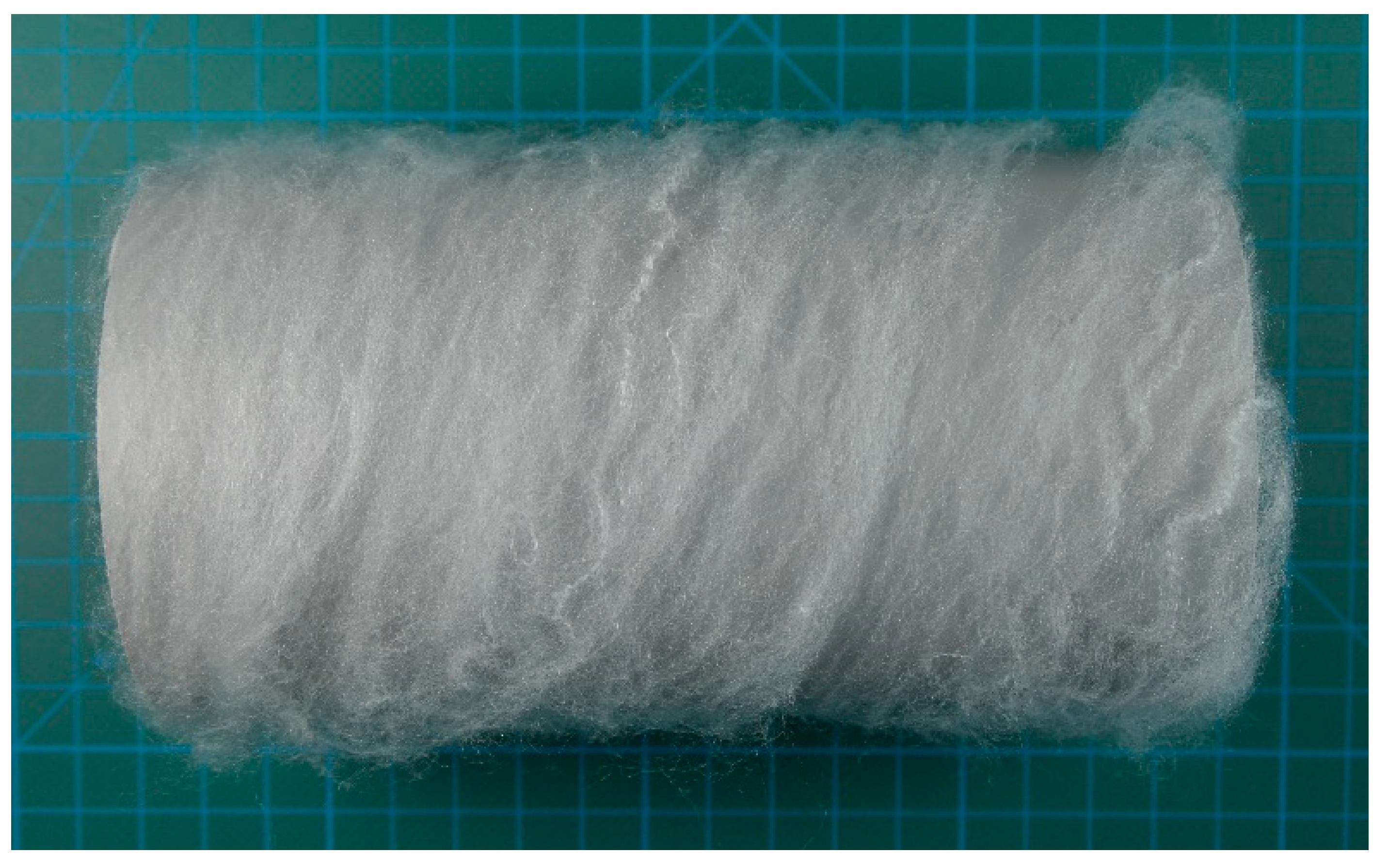
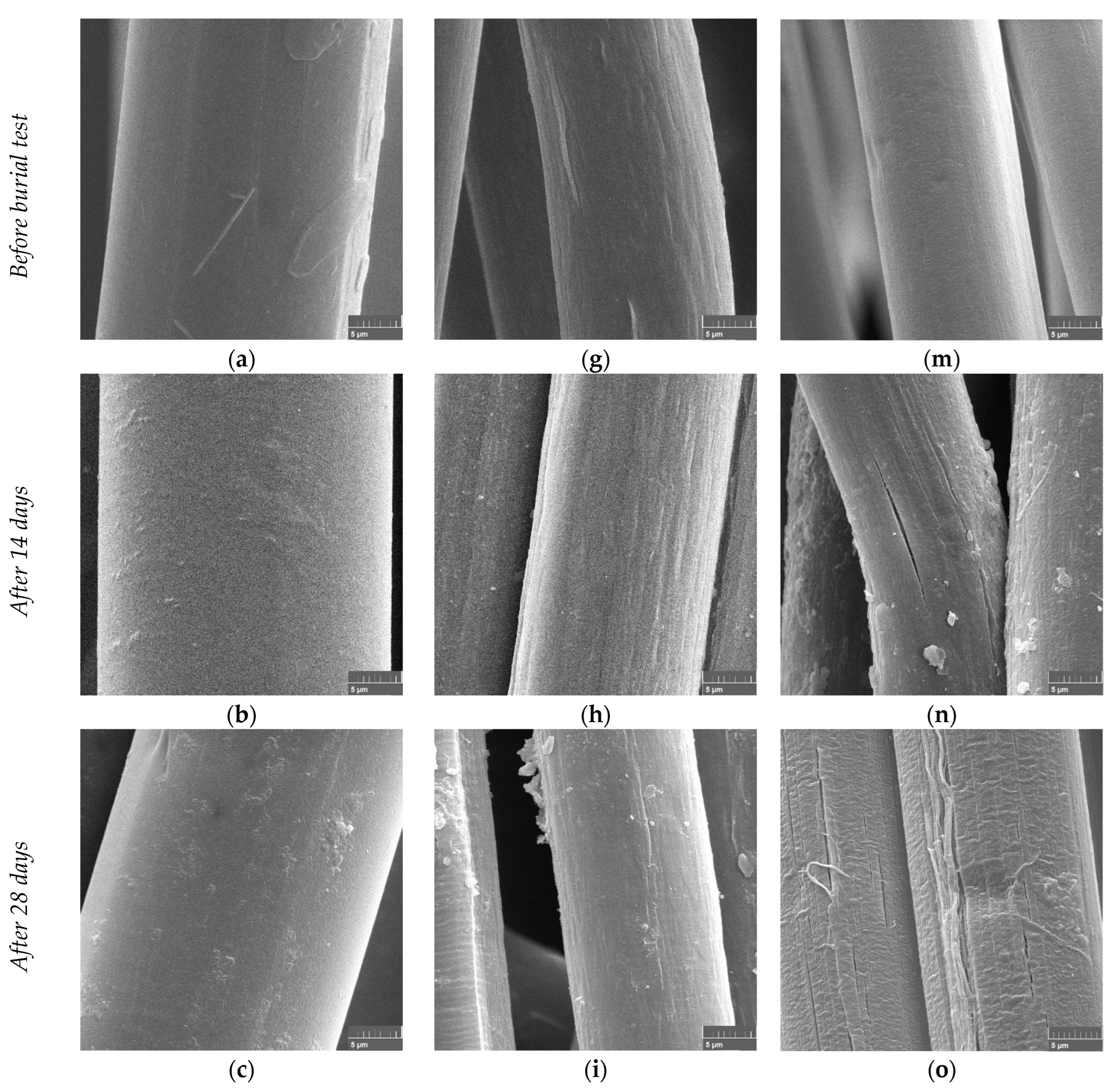



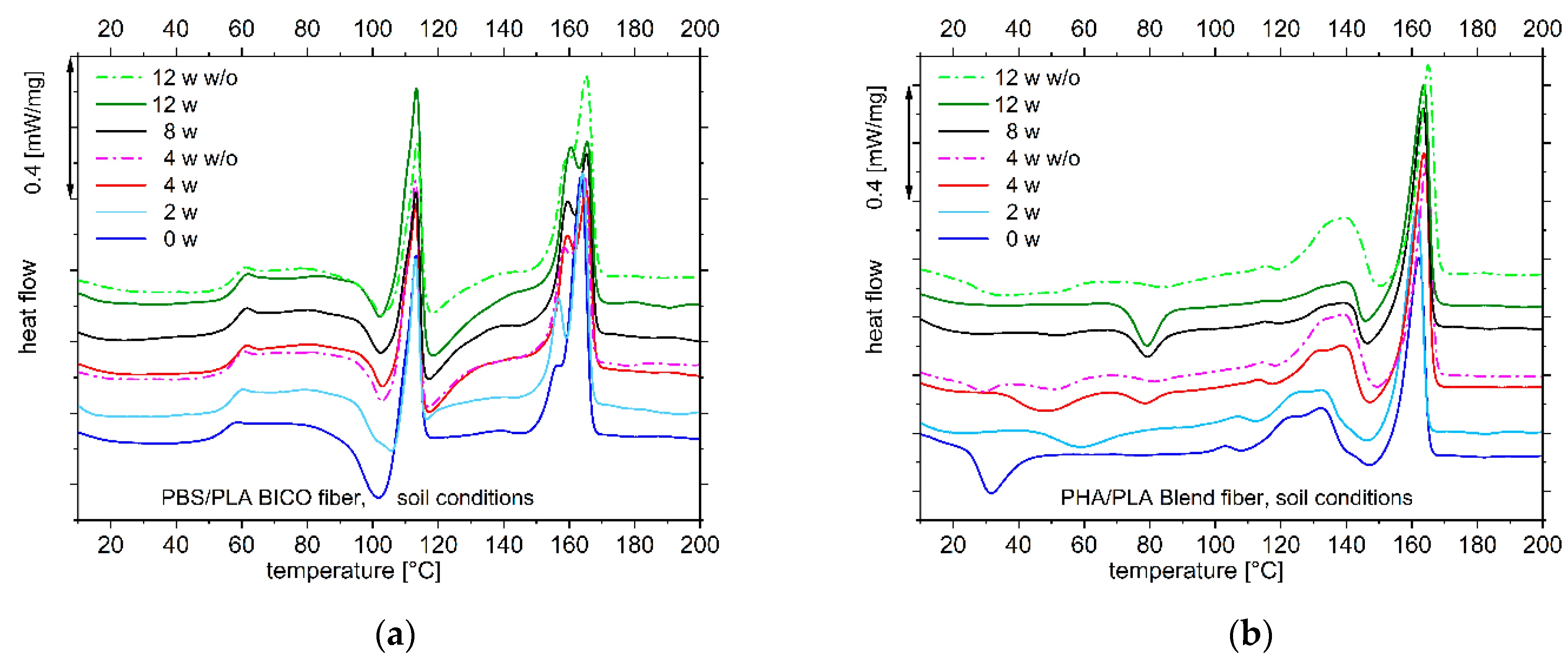

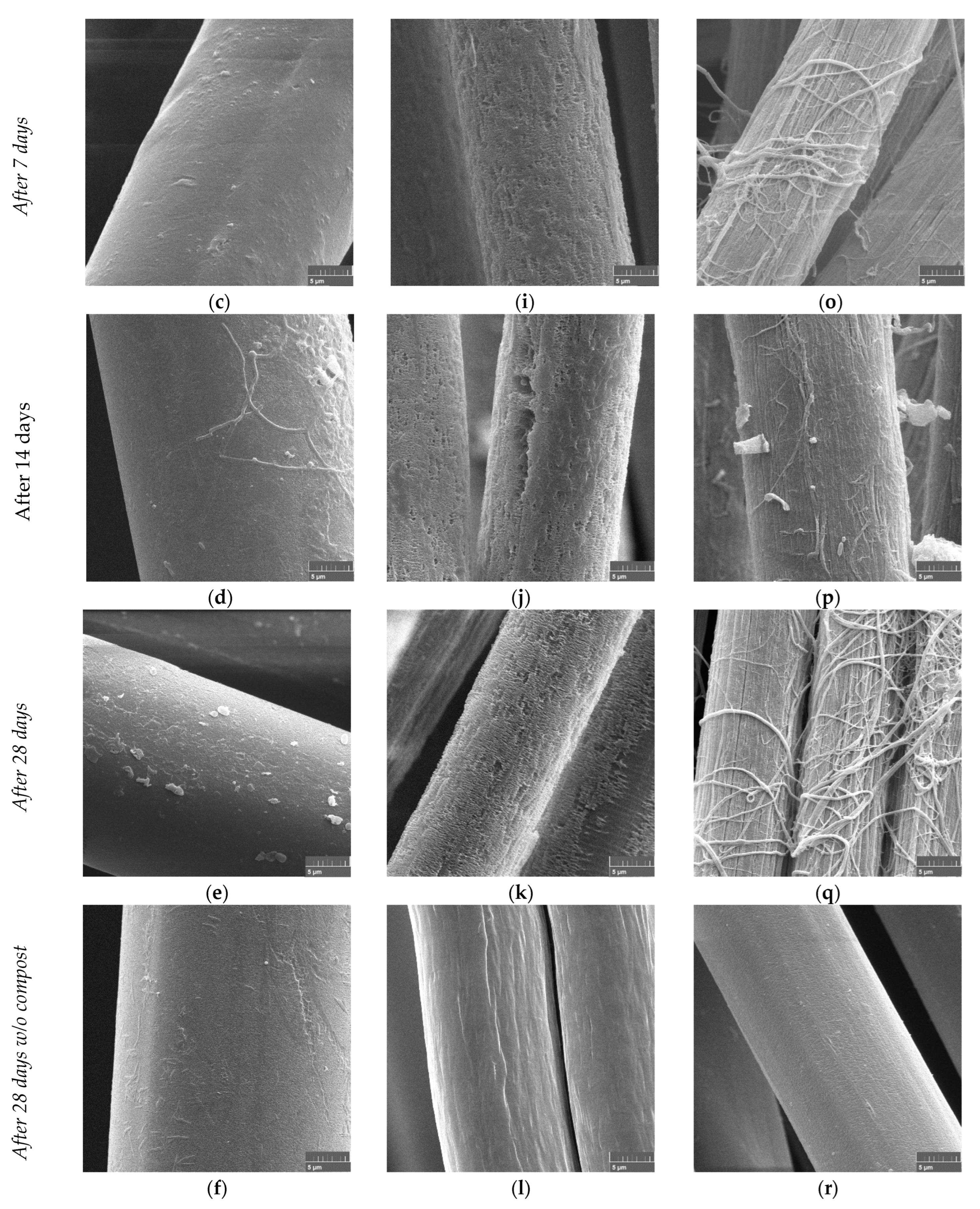
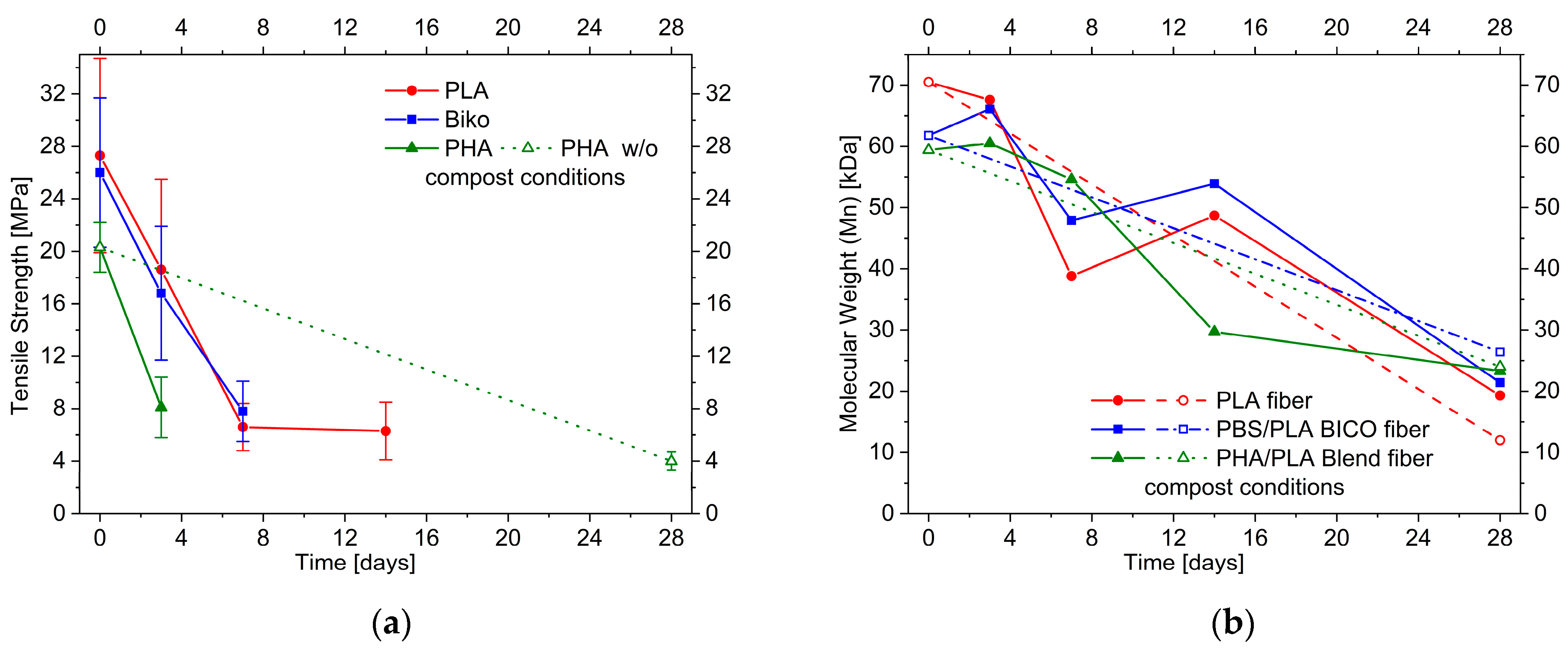
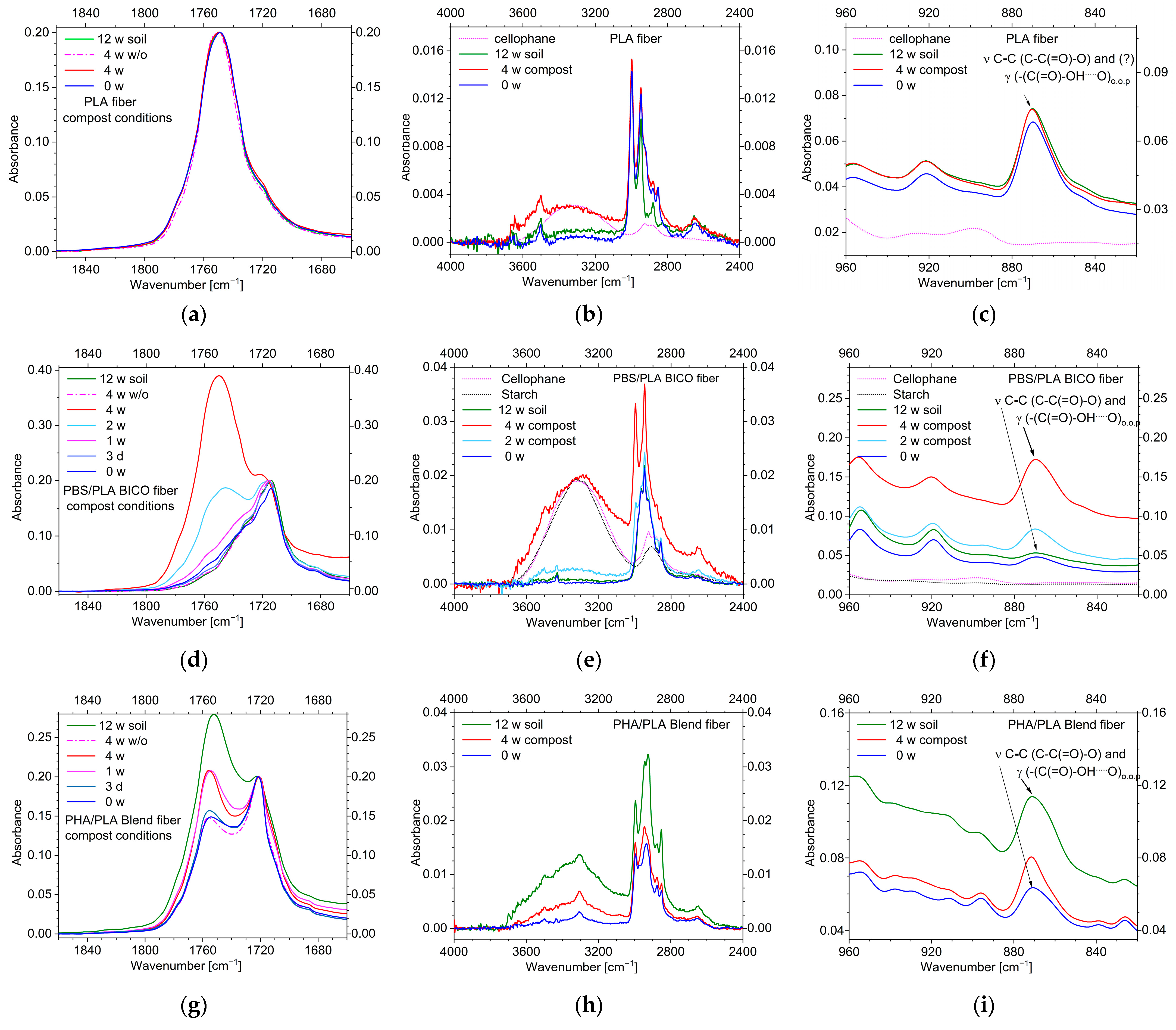
Disclaimer/Publisher’s Note: The statements, opinions and data contained in all publications are solely those of the individual author(s) and contributor(s) and not of MDPI and/or the editor(s). MDPI and/or the editor(s) disclaim responsibility for any injury to people or property resulting from any ideas, methods, instructions or products referred to in the content. |
© 2023 by the authors. Licensee MDPI, Basel, Switzerland. This article is an open access article distributed under the terms and conditions of the Creative Commons Attribution (CC BY) license (https://creativecommons.org/licenses/by/4.0/).
Share and Cite
Borelbach, P.; Kopitzky, R.; Dahringer, J.; Gutmann, P. Degradation Behavior of Biodegradable Man-Made Fibers in Natural Soil and in Compost. Polymers 2023, 15, 2959. https://doi.org/10.3390/polym15132959
Borelbach P, Kopitzky R, Dahringer J, Gutmann P. Degradation Behavior of Biodegradable Man-Made Fibers in Natural Soil and in Compost. Polymers. 2023; 15(13):2959. https://doi.org/10.3390/polym15132959
Chicago/Turabian StyleBorelbach, Pia, Rodion Kopitzky, Jörg Dahringer, and Patrick Gutmann. 2023. "Degradation Behavior of Biodegradable Man-Made Fibers in Natural Soil and in Compost" Polymers 15, no. 13: 2959. https://doi.org/10.3390/polym15132959
APA StyleBorelbach, P., Kopitzky, R., Dahringer, J., & Gutmann, P. (2023). Degradation Behavior of Biodegradable Man-Made Fibers in Natural Soil and in Compost. Polymers, 15(13), 2959. https://doi.org/10.3390/polym15132959





